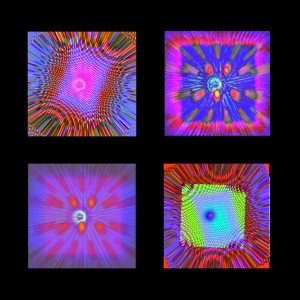The Memorial Art Gallery opened its newest exhibit, “Psychedelic: Optical & Visionary Art Since the 1960s,” with a colorful and interactive exhibition party on Sunday, Oct. 16. Activities ranged from a screening of “Woodstock” (1969) to tarot card readings to a live band and go-go dancers to free henna tattoos.
While approaching the building, the Gallery’s spire could be seen illuminated by swirling, psychedelic pink and blue lights, and ’60s music could be heard pouring out the front door. Authentic Volkswagen cars also lined the entire front walkway of the building.
At a glance, I’d say the average age of attendee was about 55. The baby boom hippies of Rochester come to relive their golden years, but that really had no effect on the amount of energy or enthusiasm at the party. And, to be clear, there were certainly people of other ages in attendance.
Guests were encouraged to come dressed in their best period swag, as one of the many activities scheduled for the evening was a costume contest. Guests’ costumes ranged from authentic counterculture clothing pulled from of the backs of closets to Halloween-type hippie kitsch.
As for the exhibit itself, it took up most of the back parlor of the museum in the Grand Gallery. Though one might think the exhibit would exclusively feature artwork from the 1960s, this wasn’t the case.
Instead, the artists have chosen to showcase artwork that is either actually from the psychedelic era, or artwork that has been created in more recent years but is inspired by it.
The exhibit begins with an informative sign, explaining the origins of the word “psychedelic” as coming from Dr. Humphry Osmond in the late 1950s. Osmond was a psychiatrist famous for medical research on the effects of psychedelic drugs. Many of the paintings featured short explanatory blurbs about the artist’s inspiration. One of the “grooviest” quotes came from painter Victor Vasarely, who spoke about his style of painting that resembles optical illusions as “the languages of the mind are but the supervibrations of the physical macrocosm.”
Most of the paintings were either done in acrylic, or oil on linen or canvas. Although these paintings weren’t done in any particularly unique medium, many of them set themselves apart by being the product of unusual inspirations rather than the routine political or cultural statements.
One such painting was “Chartreuse Gingham Check #4” by Susie Rosmarin. The intricate gridded system resembled gingham fabric, but was inspired by “fractal geometry and numerical equations.” The painting is meant to leave the viewer with “phantom colors, after-images and dizzying dislocation,” according to the artist.
In a very UR-esque note where art meets science, other pieces of artwork in the exhibit are based on inspirations such as tomographic maps of the world or even string theory.
Mark Hogensen’s “Loud Acreage” was one of my favorite pieces. His painting is unique in that it is the only one in the exhibit not done on either a square or rectangular canvas. His canvas is a combination of hard and soft angles jutting out in all directions and many of the lines appear to wrap around each other but do not, in a classical optical illusion. The painting features many different textures, colors and brush stroke directions, making it pop out like 3D when in reality Hogensen’s entire painting is flat. Hogenson describes his painting as “abstract and representational images coexist[ing] in thoughts, dreams, and visions.”
Not all of the artwork in the exhibit are paintings, however. The exhibit shows some more interactive pieces that in some cases take up whole rooms of their own. In the case of George Cisneros, his piece “Psychedelic Light Show In a Box,” takes up an entire side room that is pitch black except for a giant screen displaying moving shapes and colors to the beat of meditative music — reminiscent of the iTunes visualizer — all of which is reflected in mirrors hanging off of the surrounding walls.
Though I think one of the best parts of going to this opening party was having my name on a special cut-the-line-and-don’t-worry-about-paying list, it really was quite a spectacular exhibit. If you were to ever make the schlep to the Memory Art Gallery, now would be the time.
“Psychedelic: Optical & Visionary Art Since the 1960s” will remain at the Memorial Art Gallery until Jan. 2.
Sklar is a member of the class of 2014.

